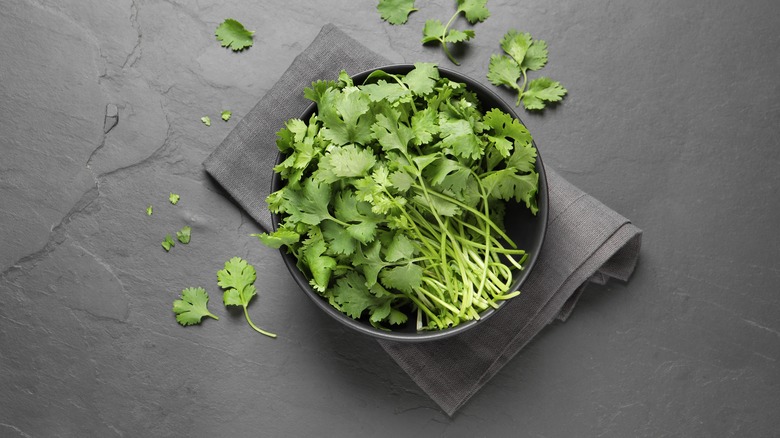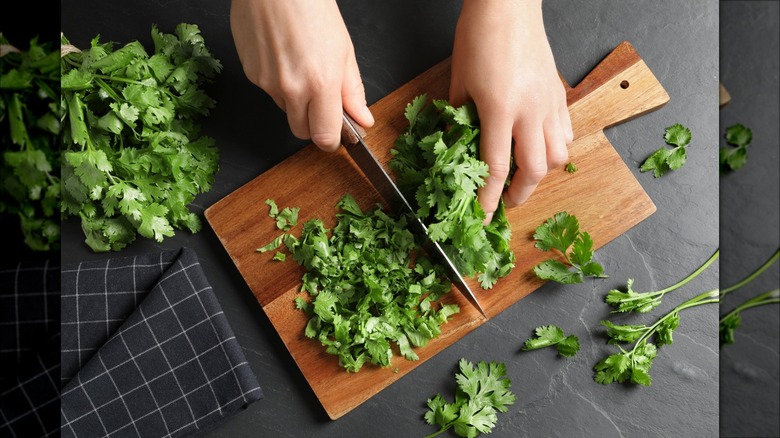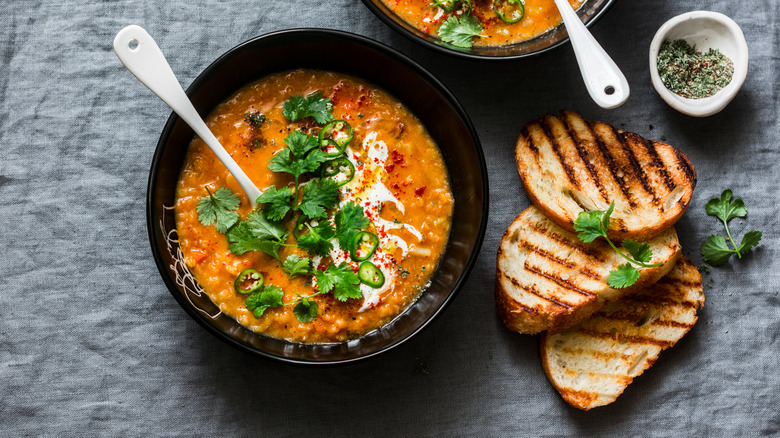Why You Should Think Twice Before Tossing Cilantro Stems
For a variety of reasons, cilantro is one of the most common herbs used in cuisines, per MasterClass. Fresh cilantro leaves infuse dishes with a strong citrus and peppery flavor. Some people say that cilantro tastes similar to parsley –- which makes sense, as it is a member of the parsley family–and some even say that it tastes like soap. According to the spice manufacturer McCormick, this soap-like flavor is due to aldehyde chemicals that occur naturally in cilantro leaves. (As Today notes, those who do experience cilantro as a soap-like taste are predisposed to it due to a specific genetic marker.)
Regardless of whether you're a cilantro fan or not, fresh leaves offer a strong flavor, and dried cilantro leaves provide a more subtle flavor and work well if you want to infuse your dish with a gentle taste. On top of that, cilantro offers several health benefits. As WebMD notes, the culinary herb is thought to reduce symptoms of Alzheimer's and Parkinson's disease, lower anxiety levels, and regulate blood sugar. Though people generally make good use of cilantro leaves, a common mistake is throwing away cilantro stems. In reality, you might benefit from keeping those stems rather than tossing them out — and there are a few key reasons why.
Cilantro stems have all the benefits of leaves, plus great texture
The main reason it's a plus to save cilantro stems if you're cooking with the herb is that they offer all the benefits that cilantro leaves do. Indeed, why get rid of something that is so beneficial? According to the food distributor Buffalo Market, cilantro stems taste just as great as leaves do — so adding them to your dish will just enhance the delicious, citrus flavor of the leaves. Cilantro stems are also just as beneficial for your health as cilantro leaves are. Like their leaves, cilantro stems contain antioxidants, can aid in leveling out blood pressure, and might even help lower inflammation (via Health).
On top of being just as tasty and healthy as cilantro leaves, cilantro stems offer the added benefit of great texture. While cilantro leaves are crisp, cilantro stems make for a crunchy bite (via Specialty Produce). This crunchy component adds another refreshing layer of texture to your dish. One of the best ways to enjoy the crunch of cilantro stems is to add them to soups, such as this Vietnamese pumpkin soup, which calls for cilantro sprigs as an optional garnish.
There are many uses for cilantro
As mentioned, one of the best ways to use cilantro stems is as a fresh garnish for soups. This is also the best way to use cilantro leaves. The reason why is that cilantro leaves do not cook well due to their fragility, per NPR.
One of the reasons cilantro is so beloved is its versatility. According to Specialty Produce, the herb is used in several different cuisines. In Mexican cuisine, cilantro is commonly sprinkled over tacos, such as these pumpkin tacos with chorizo and chipotle, giving the dishes an element of freshness. In Indian cuisine, it is a common ingredient in curry. If you don't want to use cilantro by itself as a garnish, you can also pair it with salt to enhance the flavor of dishes. The important thing is that you remember to save both cilantro leaves and stems to use in your dishes, as they both provide flavor and benefit your health.


